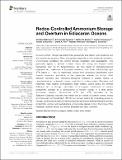| dc.contributor.author | Hallmann, Christian | |
| dc.contributor.author | Grosjean, Emmanuelle | |
| dc.contributor.author | Shapiro, Nathan D | |
| dc.contributor.author | Kashiyama, Yuichiro | |
| dc.contributor.author | Chikaraishi, Yoshito | |
| dc.contributor.author | Fike, David A | |
| dc.contributor.author | Ohkouchi, Naohiko | |
| dc.contributor.author | Summons, Roger E | |
| dc.date.accessioned | 2023-02-28T18:24:42Z | |
| dc.date.available | 2023-02-28T18:24:42Z | |
| dc.date.issued | 2021 | |
| dc.identifier.uri | https://hdl.handle.net/1721.1/148250 | |
| dc.description.abstract | <jats:p>As a key nutrient, nitrogen can limit primary productivity and carbon cycle dynamics, but also evolutionary progress. Given strong redox-dependency of its molecular speciation, environmental conditions can control nitrogen localization and bioavailability. This particularly applies to periods in Earth history with strong and frequent redox fluctuations, such as the Neoproterozoic. We here report on chlorophyll-derived porphyrins and maleimides in Ediacaran sediments from Oman. Exceptionally light δ<jats:sup>15</jats:sup>N values (&lt; –10‰) in maleimides derived from anoxygenic phototrophs point towards ammonium assimilation at the chemocline, whereas the isotopic offset between kerogens and chlorophyll-derivatives indicates a variable regime of cyanobacterial and eukaryotic primary production in surface waters. Biomarker and maleimide mass balance considerations imply shallow euxinia during the terminal Ediacaran and a stronger contribution of anoxygenic phototrophs to primary productivity, possibly as a consequence of nutrient ‘lockup’ in a large anoxic ammonium reservoir. Synchronous δ<jats:sup>13</jats:sup>C and δ<jats:sup>15</jats:sup>N anomalies at the Ediacaran–Cambrian boundary may reflect one in a series of overturn events, mixing ammonium and isotopically-light DIC into oxic surface waters. By modulating access to nitrogen, environmental redox conditions may have periodically affected Ediacaran primary productivity, carbon cycle perturbations, and possibly played a role in the timing of the metazoan radiation across the terminal Ediacaran and early Cambrian.</jats:p> | en_US |
| dc.language.iso | en | |
| dc.publisher | Frontiers Media SA | en_US |
| dc.relation.isversionof | 10.3389/FEART.2021.706144 | en_US |
| dc.rights | Creative Commons Attribution 4.0 International license | en_US |
| dc.rights.uri | https://creativecommons.org/licenses/by/4.0/ | en_US |
| dc.source | Frontiers | en_US |
| dc.title | Redox-Controlled Ammonium Storage and Overturn in Ediacaran Oceans | en_US |
| dc.type | Article | en_US |
| dc.identifier.citation | Hallmann, Christian, Grosjean, Emmanuelle, Shapiro, Nathan D, Kashiyama, Yuichiro, Chikaraishi, Yoshito et al. 2021. "Redox-Controlled Ammonium Storage and Overturn in Ediacaran Oceans." Frontiers in Earth Science, 9. | |
| dc.contributor.department | Massachusetts Institute of Technology. Department of Earth, Atmospheric, and Planetary Sciences | en_US |
| dc.relation.journal | Frontiers in Earth Science | en_US |
| dc.eprint.version | Final published version | en_US |
| dc.type.uri | http://purl.org/eprint/type/JournalArticle | en_US |
| eprint.status | http://purl.org/eprint/status/PeerReviewed | en_US |
| dc.date.updated | 2023-02-28T18:11:37Z | |
| dspace.orderedauthors | Hallmann, C; Grosjean, E; Shapiro, ND; Kashiyama, Y; Chikaraishi, Y; Fike, DA; Ohkouchi, N; Summons, RE | en_US |
| dspace.date.submission | 2023-02-28T18:11:40Z | |
| mit.journal.volume | 9 | en_US |
| mit.license | PUBLISHER_CC | |
| mit.metadata.status | Authority Work and Publication Information Needed | en_US |
